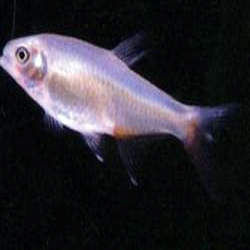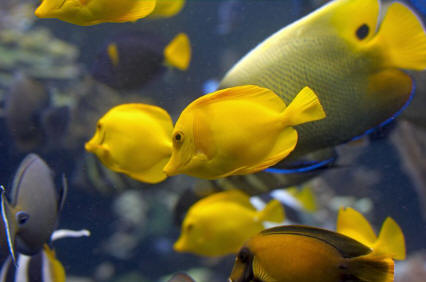Bloodfin tetra

|
Scientific Name: Aphyocharax anisitsi Price: Upon Request Origin: South America Family: Characidae NOT AVAILABLE NOW |
Technical Info
Temperature: 20 - 28 ℃
pH: 6 - 6.5
GH: 5 - 8
Max size: 5.5 cm
Min Tank size: 40 Ltr
Position in Aqua: No special swimming level
Description
The Bloodfin tetra is easily recognized on its colourful fins. The caudal fin, anal fin, ventral fins and dorsal fin are of a vivid red colour that contrasts brightly against the silvery body. This fish species is however not only appreciated for its beauty; it is also an active and sturdy fish that can live for over 10 years in captivity. The Bloodfin tetra is recommended for beginners and is an alternative to the more famous Neon tetra.
Food
Wild Bloodfin tetras are omnivore and feed chiefly on crustaceans, worms and small insects. Keep them on a varied diet in the aquarium that contains carnivore food as well as plant or vegetable matter. This species will usually accept flake food and a high quality tropical food is a good and convenient staple food. Supplement the flake food with other food types, such as live/fresh, frozen or freeze-dried products. Bloodfin tetras are known to appreciate brine shrimp and bloodworms. Since they are active they will need quite a lot of food, but you should never feed them more than what they can consume within 3 minutes.
Breeding
The Bloodfin tetra is a prolific species with a minimum population doubling time under 15 months in the wild. The Bloodfin tetra is also easy to breed in captivity. Male Bloodfin tetras are a bit more colourful than the females and feature a small hook on the anal fin. The female have a plumper body shape. Bloodfin tetras will often spawn spontaneously without any coaxing from the aquarist. Their natural instinct is to release the eggs among broad-leaved plants, but if no such plants are present they will sometimes release the eggs over aquarium glass. The eggs are not adhesive. During the spawning, the Bloodfin tetra will leap out of the water and the eggs will drop down. One female will usually produce between 300 and 500 eggs during each spawning. Since it is an egg-shattering species that do not engage in parental care, it will not hesitate to eat its own offspring. A lot of eggs and fry will therefore be eaten by the parents, or by other fish in the aquarium. You can increase the chance of fry survival by keeping the aquarium densely planted. Do not only use broad leafed plants in your Bloodfin tetra aquarium; include fine-leaved species as well since they provide better protection. You can also spread beads over the substrate to create hiding spots for eggs and fry. Professional Bloodfin tetra breeders usually set up separate breeding aquariums from which the adult fish is removed directly after spawning. This will promote a much higher fry survival rate.
Compatible with
Black Phantom Tetra, Cardinal Tetra, Corydoras Catfish, Ghost Shrimp, Glass Fish, Glow Light Tetra, Guppies, Honey Gouramis, Harlequin Rasbora, Ram Cichlid, White Cloud
Note
The Bloodfin tetra is a shoaling fish and you should therefore keep at least five specimens together. When a Bloodfin tetra is kept alone, or in a very small group, it will usually become very shy and spend most of its time hiding. In a shoal, they are much more bold and active and spend a lot of time out in the open. A Bloodfin tetra can sometimes leave the group and explore the aquarium on its own, but it will always return to the safety of the group as soon as it feels threatened. The Bloodfin tetra shoal will spend most of its time in the upper and middle water layers. In a shoal, the Bloodfin tetras are very active and entertaining to watch. Since this is a peaceful species, it will work well in a community aquarium with other non-aggressive species of similar size.

